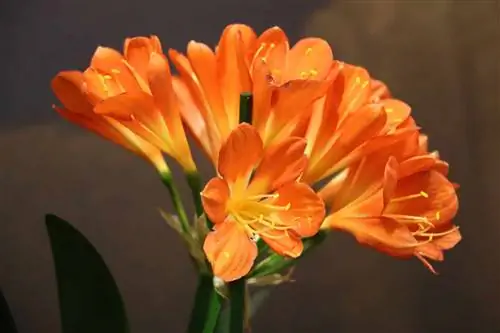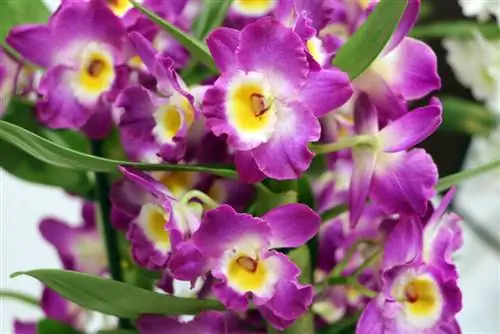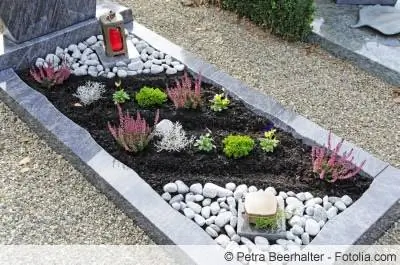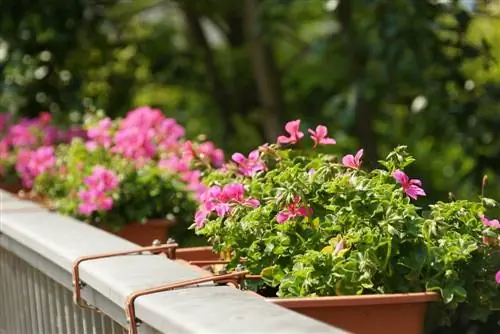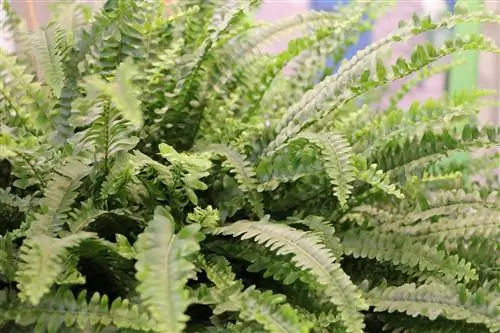- Author admin [email protected].
- Public 2023-12-17 03:39.
- Last modified 2025-01-24 12:45.
Plants for the children's room should be non-toxic and easy to care for. There are various species that are ideal for this purpose and can be easily kept in the pot.
7 beautiful flowering plants
Blue Lieschen (Exacum affine)
- Growth height: 15 cm to 30 cm
- Growth width: 10 cm to 15 cm
- Flowering time: mid-May to mid-September
- annual, compact, bushy, well branched
- ovoid foliage, olive green
- cup-shaped flowers, gentian blue, white, pink, violet, frequent blooming
- sunny to partially shaded
- ideal as a splash of color in the children's room
- pleasantly scented
Chinese rose marshmallow (Hibiscus rosa-sinensis)
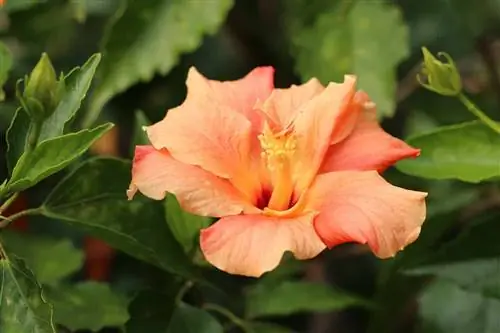
- Growth height: 100 cm to 300 cm
- Growth width: 150 cm to 200 cm
- Flowering time: March to mid-October
- compact, bushy, upright, evergreen
- ovoid foliage, 4 cm to 10 cm long, pointed, green
- 5 funnel flowers, individually, available in numerous colors
- sunny to partially shaded, south window ideal, protected from rain and wind, protect from midday sun, over 20°C
- Leaves, flowers and roots edible
- very decorative
False Gloxinia (Sinningia speciosa)
- not to be confused with the genus Gloxinia
- Growth height: 20 cm to 40 cm
- Growth width: 20 cm to 30 cm
- Flowering period: June to the end of August
- annual, bushy, forms tubers as survival organs
- long leaves, elliptical, lush green, hairy
- large bell-shaped flowers, sitting in spikes, white, pink, red, blue-purple, purple, unfilled, rarely slightly double
- bright, avoid direct sunshine, warm, permeable, sensitive to limescale
- Plant needs sufficiently high humidity
Fuchsias (Fuchsia)
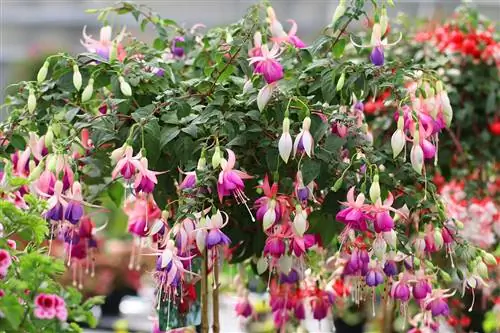
- numerous species and varieties available
- Growth height and width depending on species
- sunny to shady, protect from direct midday sun
- form bell-shaped flowers in a wide variety of colors
Tapir flower (Crossandra infundibuliformis)

- Growth height: 20 cm to 50 cm
- Growth width: 25 cm to 30 cm
- Flowering time: mid-May to the end of September
- herbaceous growth, bushy, upright, evergreen
- Leaves up to 10 cm long, lanceolate, broad, wavy, lanceolate, dark green
- Flowers up to 2 cm in diameter, borne on 15 cm long spikes, orange, salmon-colored, pink
- bright, shaded, protect from direct midday sun, sensitive to limescale, min. 18°C all year round, humus
- suitable for indoor tropical gardens
African Violet (Saintpaulia Ionantha)
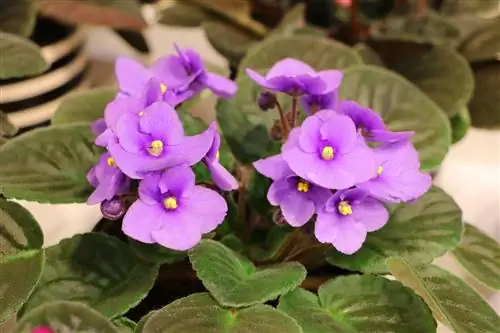
- Growth height: 5 cm to 20 cm
- Growth width: 5 cm to 250 cm
- blooms all year round
- forms dense cushions, herbaceous, low, evergreen
- rounded, heart-shaped leaves, fleshy, hairy, grows in rosettes, light green or intense crimson red
- Umbelliferous flowers, white, pink, red, purple, multicolored, striking yellow anthers
- bright, no direct midday sun, 18°C to 24°C all year round, protect from drafts, evenly moist substrate, sensitive to limescale
- original wild forms are slightly smaller
- never water the plant directly
House slipperflower (Calceolaria herbeohybrida)
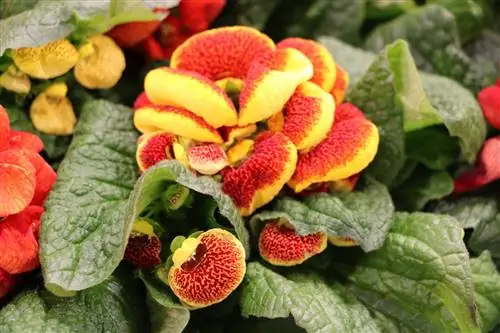
- available in numerous varieties
- Growth height: 15 cm to 45 cm
- Growth width: 20 cm to 40 cm
- Flowering period: February to mid-May
- herbaceous growth, dense, annual
- decorative leaves, long, oval, fleshy, gently hairy
- lip flowers standing in panicles, reminiscent of slippers, yellow, red, multicolored
- sunny to shady, protect from direct midday sun, not too warm, fresh, humus, sandy
- die after flowering
9 non-toxic nursery green plants
Mountain Palm (Chamaedorea elegans)
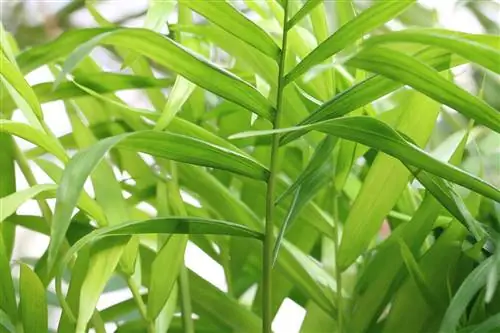
- Growth height: up to 200 cm (usually smaller in pots)
- slender trunk, evergreen
- up to 60 cm long palm fronds, rich green tone, up to 40 feathers
- inconspicuous flowers in yellow color
- bright or partial shade, avoid direct midday sun, well-drained, slightly acidic or slightly alkaline
- extremely robust
- ideal for beginners
Forstersche Kentia (Howea forsteriana)
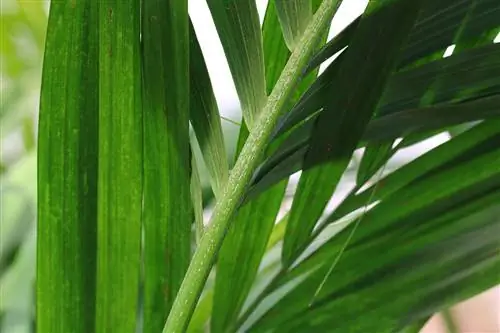
- Growth height: 1,500 cm to 2,000 cm (significantly smaller in pots)
- Growth width: up to 1,500 cm (depending on cultivation)
- wide growth, slow, covered with leaf scars, evergreen
- Overhanging palm fronds, up to 260 cm long, individual leaflets up to 90 cm long, rich green
- partly shaded, tolerates shade, well-drained, humic, extremely undemanding
- ideal for beginners
Garden cress (Lepidium sativum)
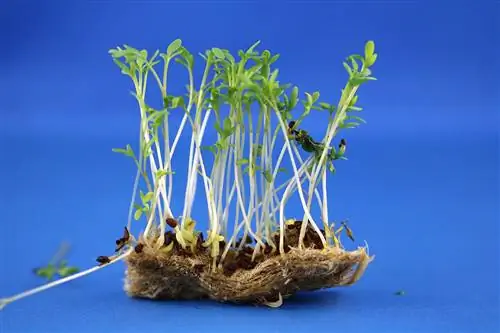
- Growth height: up to 40 cm
- Flowering time: July to mid-August
- herbaceous growth, annual, upright branched, glabrous, blue-green in color
- pinnate leaves, thin, light green
- small flowers with 4 petals, white, pink
- sunny to partially shaded, undemanding, humic, loose, moist
- edible
- forms seeds with valuable ingredients
- Seeds taste slightly spicy
- Ingredients of the seedlings: mustard oil glycosides, vitamin C, carotenes
Note:
Cress is very popular with children because the grass grows so quickly that you can easily watch it grow. Since the cress is very easy to care for, the little ones can grow it themselves.
Gold Fruit Palm (Dypsis lutescens)
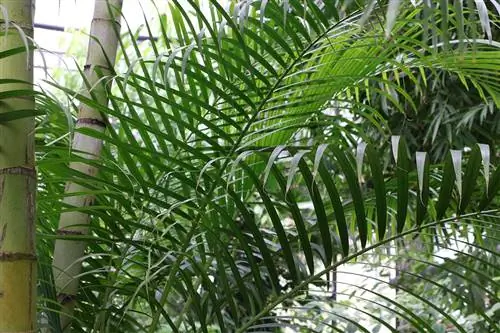
- Growth height: up to 400 cm
- Growth width: up to 250 cm
- slow growth, divided into several trunks, upright, evergreen
- palm fronds up to 130 cm long, fresh green, overhanging, pinnate
- Fruits and flowers in indoor cultivation are hardly possible
- bright, avoid direct sun, at least 20°C all year round, not too dry, protect from drafts, rich in nutrients, humus
- ideal for hydroponics
Green Lily (Chlorophytum comosum)
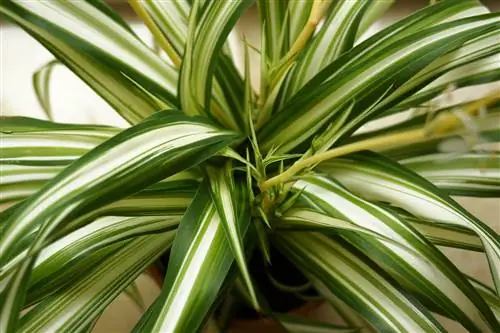
- Growth height: up to 70 cm
- Growth width: 45 cm to 90 cm
- Perennial, low growth, perennial, forms fleshy roots
- lanceolate foliage, up to 45 cm long, up to 2.5 cm wide, arise from a rosette, green-white, green, rarely striped
- White flowers visible all year round, overhanging up to 100 cm
- bright, protect from direct midday sun, above 10°C all year round, nutrient-rich, humus, loose, fresh-moist, loamy
- considered as an air purifier
- improves the indoor climate
- suitable for hanging baskets
Chives (Allium schoenoprasum)
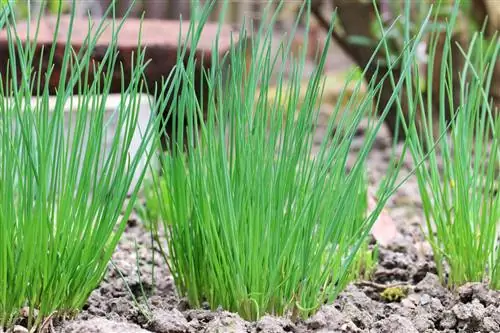
- Growth height: up to 50 cm
- Flowering time: mid-May to the end of August
- herbaceous growth, persistent, upright, forms bulb as a survival organ
- 2 to 3 tubular leaves, about 30 cm long, green
- radially symmetrical spherical flowers, inflorescences are false umbels with up to 50 flowers, white, pink, red, purple, multicolored
- sunny to partially shaded, undemanding, fresh-moist, nutrient-rich, well-drained, humus, calcareous
- edible
- Ingredients: Vitamin C, provitamin A, minerals, essential oils, folic acid
- classic culinary herb
- popular with pollinator insects
- Children can observe insects such as bees or butterflies as they feed
Tip:
If your kids love chives, you can even grow arugula (Eruca vesicaria ssp. sativa). The leaves grow quickly and are also edible (not for everyone because of the bitter aroma).
Hollypalm (Rhapis excelsa)
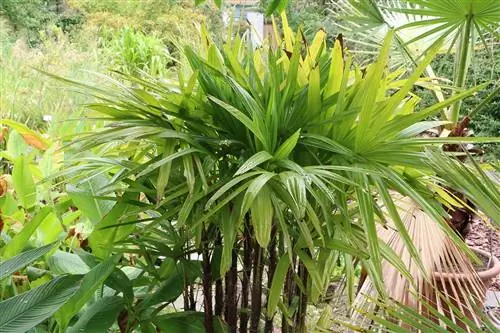
- Growth height: 80 cm to 200 cm
- Growth width: up to 60 cm
- forms numerous individual trunks, shrubby growth, evergreen, bushy, forms a rhizome
- leaves up to 30 cm long, slender, drooping, arranged in pinnacles, lush green
- bright to shady, no direct sun, warm, well-drained, slightly acidic
- ideal substrate is palm soil
- considered as an air purifier
Dwarf pepper (Peperomia obtusifolia)
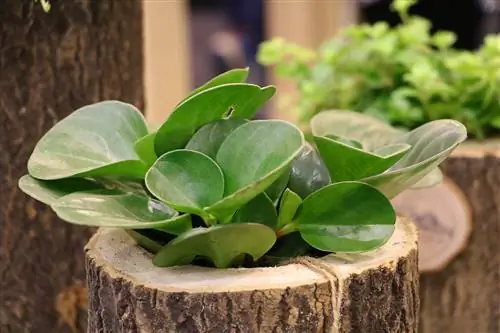
- Growth height: 15 cm to 30 cm
- Growth width: 5 cm to 25 cm
- grows as a perennial, low, bushy, densely branched, evergreen
- 5 cm to 8 cm long leaves, leathery surface, fleshy, elliptical, green, light variegated
- bright, shaded, does not tolerate direct sun, min. 18°C, protect from drafts, undemanding, permeable
- inconspicuous flowers from mid-April to December
- Inconspicuous berries can be trained
- suitable for hydroponics
Cypergrass (Cyperus)

- available in numerous types and varieties
- Growth height: depending on species
- Growth width: depending on species
- upright growth, herbaceous, stems quite thin, depending on the species, stalks are close or loose together
- Leaves up to 25 cm long, overhanging, dark green, slender
- sunny or bright, warm, humic, nutrient-rich
- forms inconspicuous flowers
- ideal for hydroponics
4 nursery succulents featured
Real Aloe (Aloe vera)
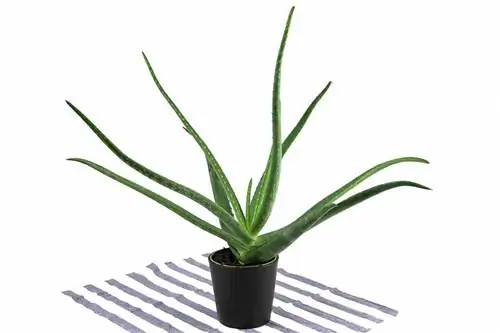
- Growth height: 40 cm to 60 cm
- Growth width: 30 cm to 60 cm
- Flowering time: early January to mid-February
- grows as a rosette, dense, usually without a trunk
- Leaves up to 50 cm long, succulent, green, usually 16 on a plant, armed with spines
- Stingers do not pose a danger to children
- up to 90 cm long inflorescence, maximum of 2, forms flower clusters, 30 cm to 40 cm long, up to 6 cm wide, yellow, orange, red
- full sun, warm, lime-loving, well-drained, mineral, sandy
- ideally use cactus or succulent substrate
- Leaf juice important for the cosmetics industry
- Leaf juice tastes bitter
Foreverleaf (Aeonium arboreum)
- Growth height: 50 cm to 100 cm
- Growth width: up to 60 cm
- Flowering time: mid-April to the end of August
- weakly branched subshrub, woody
- Leaves are rosettes, flat, pointed, obovate and ovate, up to 15 cm long, fleshy, green
- golden yellow flowers in panicles, inflorescence up to 25 cm long, individual flowers significantly smaller
- out of the sun, bright, no direct midday sun, room temperature completely sufficient, loamy, mineral, permeable
- cactus soil is ideal
- pH value: 6.5
- ideal in combination with other succulents or alone
Money Tree (Crassula ovata)
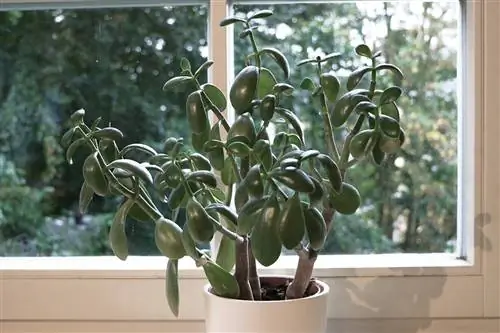
- Growth height: 60 cm to 250 cm (size can be easily controlled in the pot)
- Growth width depends on cut
- Shrub, evergreen, well branched, shoots in a gray-green color
- Leaves up to 9 cm long, about 4 cm wide, fleshy, oval, glabrous
- sunny or partially shaded, does not tolerate dry heating air, undemanding to substrate, loose
- belongs to the classic Cape flora
- With luck, it blooms in white or pink after about 10 years
Easter cactus (Hatiora hybrids)
- Growth height: 20 cm to 45 cm
- Growth width: 20 cm to 30 cm
- Flowering time: March to mid-May
- Epiphyte, shrub, well branched, overhanging
- Shoots divided into sections, length of 5 cm, various shapes, light green, hairy with areoles, no thorns
- Decorative bell flowers, up to 4 cm wide, emerge from the tips of the shoots, white, pink, orange, scarlet
- bright, avoid direct sun, well-drained, cactus soil
- the inconspicuous fruits are non-toxic
- ideal for hanging baskets or hanging pots
Note:
Although the Easter cactus is a cactus, you should avoid other types of the family in the children's room. The thorns are too dangerous for small children and can quickly lead to injuries.


